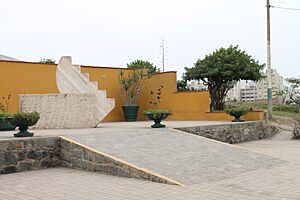Ancon (archaeological site) facts for kids
Ancon (archaeological site) is an amazing ancient place located on the central coast of Peru. It's found north of the Bay of Ancon, in the Ancón District. This site is super important because it has a huge ancient cemetery, called a necropolis, with many old graves from before the Spanish arrived.
People have lived in Ancon for a very, very long time. The oldest signs of humans here go back about 10,000 years! This means Ancon has a continuous history through almost all periods of Andean life.
Contents
Where is Ancon?
The Ancon area is about 42 kilometers (26 miles) north of Lima, the capital city of Peru. It's a beach resort today.
Long ago, Ancon was also famous for a peace treaty signed there in 1883. This treaty, called the Treaty of Ancón, ended a war between Peru and Chile.
The ancient Ancon site is located north of the Ancon Bay. It is also west of the main Pan-American Highway. Another important ancient site nearby is El Paraíso, Peru.
A Long History of People
Ancon is special because people lived there continuously through almost all periods of Andean history. This means from about 8000 BC, during the Stone Age, all the way to the time of the Incas around 1500 AD. Even after that, during Peru's colonial and modern times, people continued to live in the area.
Discovering Ancon's Past
The first big discoveries of ancient tombs in Ancon happened in 1870. This was when workers were building a railroad from Ancon to Pasamayo.
Later, in 1875, two German experts, Wilhelm Reiss and Alphons Stubel, came to Ancon. They dug up many areas around the ancient cemetery. They published a huge study with drawings in Berlin. Many people think their work helped start scientific archaeology in Peru.
Over the years, many other archaeologists studied Ancon. Max Uhle was one of the first to study the large shell mounds, which are piles of ancient shells and trash.
Later, in the 1940s, Julio C. Tello led a big project. His team explored a large area and found 1,570 tombs! They also found over 14,000 ancient objects. This work taught us a lot about the different cultures that lived in Ancon.
A researcher named Rebeca Carrión Cachot summarized what was known then. She said Ancon had remains from three main periods:
- A very old period with signs of the Chavin culture.
- A middle period with influences from the Wari culture.
- A more recent period with items from the Chancay and Inca cultures.
In 1959, Jorge C. Muelle found even older layers. He discovered evidence of people living in Ancon before the Chavin culture. This pushed back Ancon's history by thousands of years!
What Ancon Looks Like Today
Archaeologists have divided the Ancon site into different important areas:
- Ancon I: This area includes "Las Colinas" and "El Tanque," which are places where ancient people left their trash and old tools.
- Three Walls: These are old walls in the western part of the site.
- Ancon II or Necropolis: This is the huge ancient cemetery, also known as "Miramar."
- Other areas: These include the Air Base area, Cerro Pasamayo, and ancient camps in the plains of Ancon and Piedras Gordas.
Ancon's Earliest People
The oldest evidence shows that people lived in Ancon about 10,000 years ago. They were found in the plains of Ancon and Piedras Gordas. They used special stone tools, like spear points, similar to those found from the Paiján culture along the Peruvian coast.
During a later period, ancient fishermen lived around the Bay of Ancon. They were good at catching seafood and collecting shellfish. You can see evidence of this in the large mounds of shells they left behind, especially in the Las Colinas area.
Because the land around Ancon is very dry, these early people focused on using resources from the ocean. However, they also traded with farming groups who lived further inland to get other food.
Ancon Site Museum
The Ancon Site Museum opened in 1993. It's a great place to see more than 2,500 ancient objects found at the archaeological site. These include beautiful pottery, old textiles (fabrics), and even mummies!
See also
 In Spanish: Ancón (sitio arqueológico) para niños
In Spanish: Ancón (sitio arqueológico) para niños




